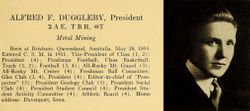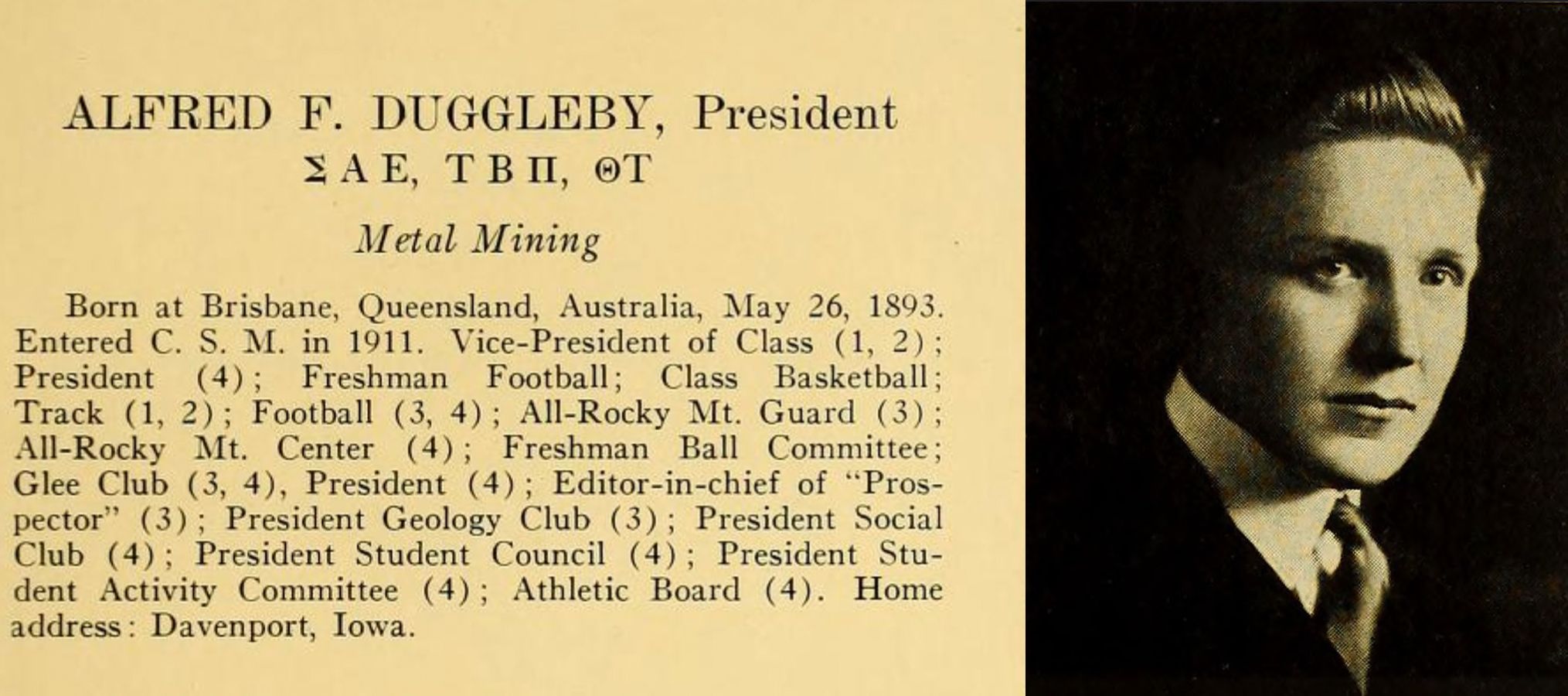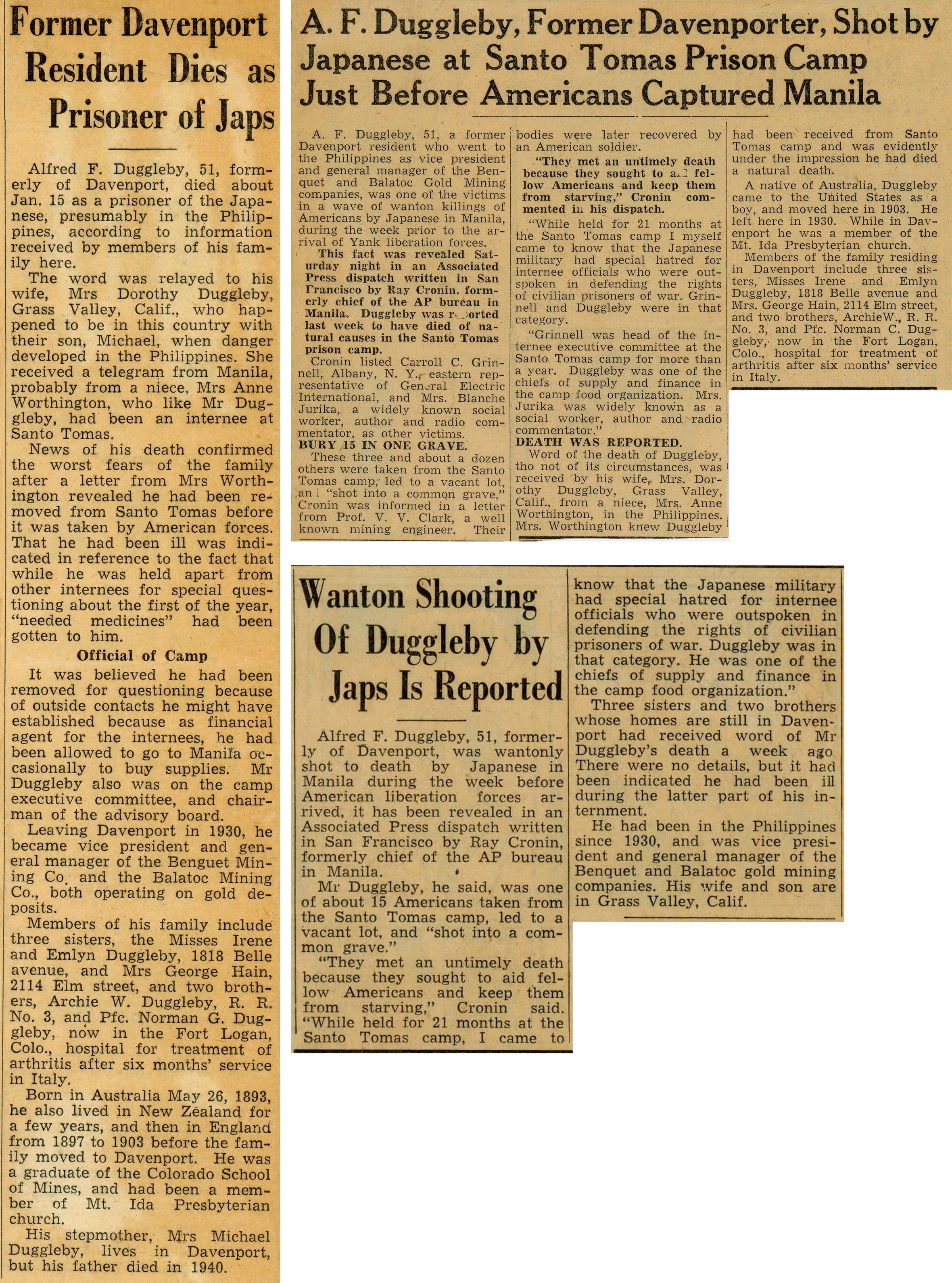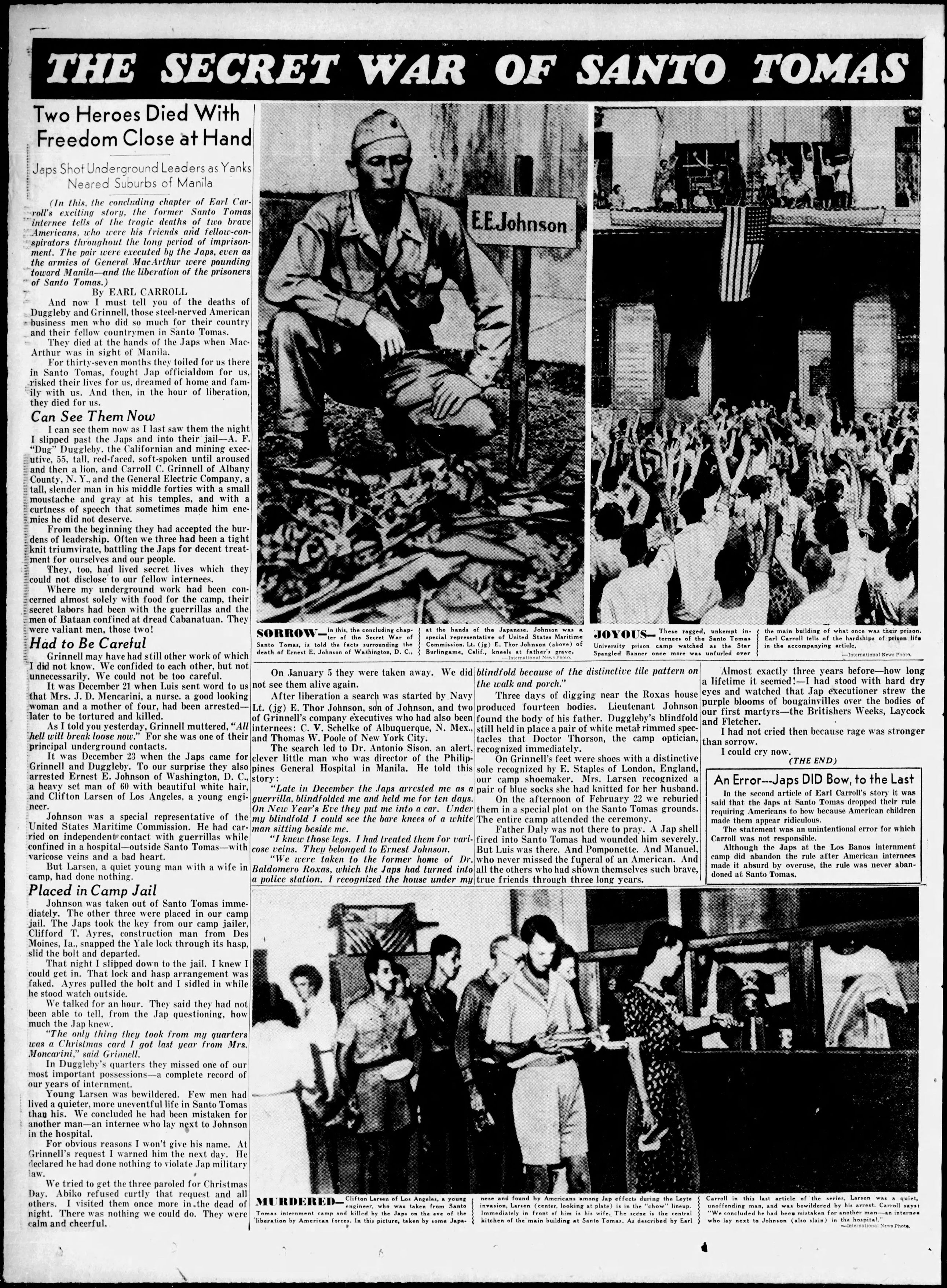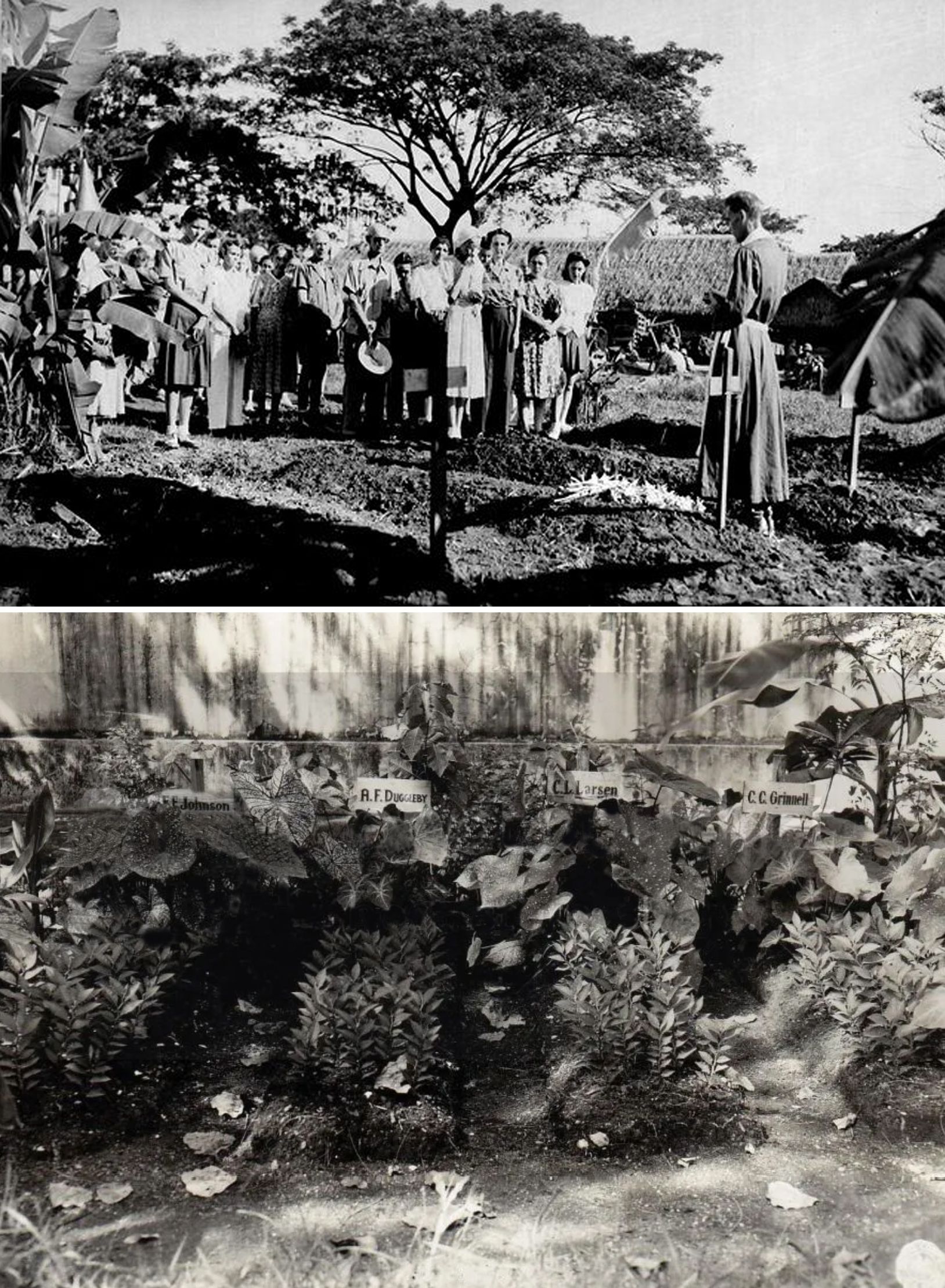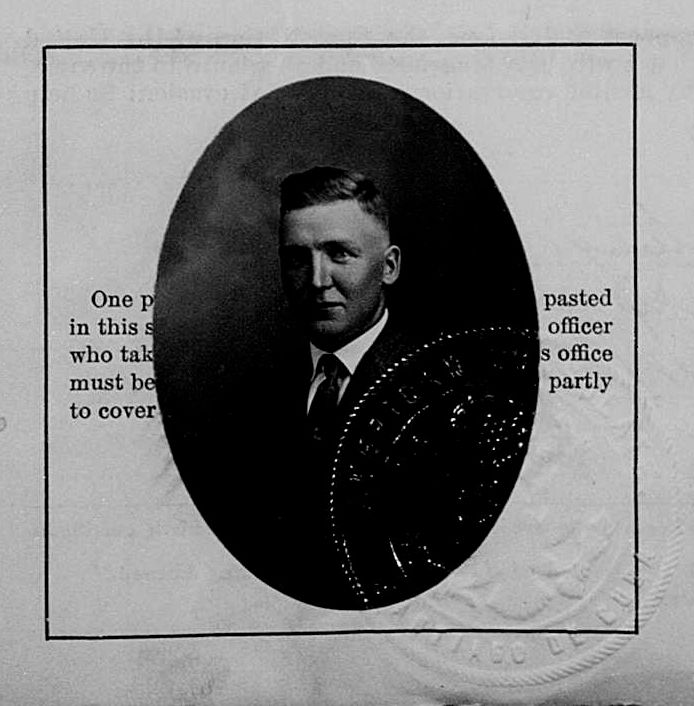He went to the Colorado School of Mines and graduated on 28 May 1915 with a degree as "Engineer of Mines". Alfred Francis Duggleby and Charles Arthur Rogers Thesis: The production of cobalt steels in the electric furnace and the study of their properties.
Alfred was Mine Superintendent of the Juragua Iron Company in Firmeza, Oriente, Cuba in 1917. He wasn't there very long as he had returned to Davenport in December 1917 to enlist in the U.S. Army. Alfred was a 2nd Lt. in the Army during WWI from 14 December 1917 until his discharge on 20 September 1919.
In 1920 he was General Superintendent of the Alleghany Mining Company at Alleghany, California.
He became Vice-president of a major mining company and spent lots of time in the former Belgian Congo, Africa.
In 1930 Alfred Francis Duggleby accepted a position in the Philippines as mining engineer in charge of operations with the Benguet Consolidated and Balatoc Mining Companies, two of the largest gold mining companies in the Philippines. The Benguet mine was known as "the Mother Mine of the Philippines". By 1937 he was Vice-President and General Manager of both companies.
He married Dorothy Isabel Herdman (15 May 1903 Philippines -16 September 1987, Menlo Park, San Mateo County, California) in 1937. They had one son, Michael Searles Duggleby. (1939-?).
Dorothy and Michael had returned to the US in September, 1941 on the Pan Am California Clipper, due to the serious illness of her mother. They were in Grass Valley, California when Japan attacked Pearl Harbor on 07 December 1941. That same day (08 December 1941 Manila time) Japan attacked the Philippines.
On the 15th of December Alfred sent a cable from Baguio "stating that all was well and business was operating as usual at Manila and Baguio." How quickly things changed.....
The Japanese arrived in Manila on 02 January 1942 and immediately started rounding up the remaining Americans and other "enemy nationals". During the first days of January 1941, all British and Americans citizens were ordered to report, and by 27 January, 3,348 (men, women and children, including Alfred) were housed in the Japanese internment camp on the campus of Santo Tomas University in Manila. The Japanese claimed that their internment would be a short term affair in order to register the civilians. In fact the Japanese did not even classify the civilians as internees, but instead as being under their "protective custody." They were told to bring only food and clothing for three days. For most it lasted over three years.
Though in charge of the camp, the Japanese largely left the camp to run itself, and
established the Executive Committee as the internal government of the camp. On 07 January 1941 the very first organizational meeting was held and an Advisory Committee was formed with, Mr. A. F. Duggleby acting as Chairman. Alfred became a member of the first "Central" Committee. The Japanese Commandant (Mr. R. Tsurumi) also appointed Alfred to the Finance and Supplies Committee. He was responsible for the "procurement of Construction, Sanitation and Miscellaneous Supplies." He then was appointed (September 1942) Chairman of the Family Aid Committee for the internees. As the financial agent for the internees, he was allowed to leave the camp occasionally to buy supplies.
In July of 1942, his family received official word through the Red Cross that Alfred was being held prisoner by the Japanese. That was the first word heard about him since the fall of the Philippines.
Two days before Christmas, 1944, Alfred Francis Duggleby, along with three other Americans was arrested by the Japanese.
23 December 1944 - Santo Tomas Internment Camp
23 December "started ominously for the Camp, when the Commandants staff and guards made a surprise search of Shanty Area B at roll call time. But worse was to come, as camp records show. In the afternoon (of this same day) a number of military police came into the Camp and a platoon of soldiers were also brought up from the gate. The Hospital and compound were closed and thoroughly searched. Guards were posted at the doors and inside the Main Building, and most of the Main Buildings was also searched. Mr. E. E. Johnson was arrested about 3 p.m. and presumably taken out of Camp for investigation; Mr. C.C. Grinnell, A.F. Duggleby and Clifford I. Larsen were arrested later and held in the Commandant's office until after 7 p.m. when they were lodged in the Camp jail. The shanties of these four internees were thoroughly searched by the military police and soldiers and also Mr. Duggleby's sleeping quarters in the Finance and Supply office. No indication was given as to the reason for their arrests." Source: Santo Tomas by Stevens, Frederic Harper ( Stratford House, Inc., New York, 1946), page 70.
"This afternoon about 15 Jap M.P.'s came into camp & tore the place apart – Grinnell, the head of the camp and Duggleleby, one of the camp's leaders were thrown into jail – No one knows why – But I have my suspicions & they center around getting news outside as to the terrible conditions which prevail here – And they are terrible –" Source: Diary of Albert E. Holland, internee
On the night of 23 December, Carroll C. Grinnell, Chairman of the Internees Committee and Alfred F. Duggleby, head of the Family Aid Committee, together with Ernest E. Johnson who works in Grenell's office and a man by the name of Clifford L. Larsen, were imprisoned in the camp jail by the Japanese Kempeitai (Japanese Military Police) for *reasons which were never made clear even to the local Japanese staff. Grenell's office and shanty were sealed. A number of papers were taken from Duggelby's office. Source: Diary of Raymond Leyerly, former chief of police of Manila and internee at Santo Tomas.
"Strange, as they were very close to the Japanese. They were the trustees." said internee Neville Stopford. The arrest of these four men profoundly shocked the Camp.
*They were arrested on suspicion of communicating and aiding the resistance forces.
05 January 1945
In the afternoon of 05 January, Carroll, Duggleby and Larsen were removed from the camp to an unknown destination.
14 January 1945
The minutes of the Internee Committee have the following statement under date of Jan 14, 1945: "In response to inquiries made by the Committee, the Commandant's office advised that they had no information as to the whereabouts of the three internees removed from camp by the military police on Jan. 5th...."
"No information was ever given to the Camp authorities with respect to the charges for which these men were imprisoned"
On or about 15 January 1945
The four men were executed by the Japanese Kempeitai (just weeks before the camp was liberated).
Carroll Calkins Grinnell – General Electric
Alfred Francis Duggleby – Benguet Consolidated Mining Company
Ernest Emil Johnson – United States Maritime Commission
Clifford Lawrence Larsen – Atlantic Gulf and Pacific Company
03 February 1945
Santo Tomas Prison internees were freed by the U.S. Army.
After their release Tom Poole and Charles Schelke ( Schelke was general manager at G.E.) and Lt. E. Thor Johnson, U.S.N. (son of Ernest E. Johnson), stationed in Manila, began searching to find out what had happened to the four men.
After a number of dead ends, the breakthrough came after meeting with Dr. Antonio Sison who informed them that he had been imprisoned with Ernest E. Johnson at the Japanese Military Police Headquarters in the former home of Dr. Paldomero Roxas, on the corner of Calle Cortabitarte and A. Mabini in Malate. Dr. Antonio Sison was released on 02 January 1945 and said that he learned after his release that the others had been executed.
19 February 1945
The men went to the Headquarters of the Japanese Military Police building and searched room by room but found no evidence of any of the four men having been there. A Filipino who had been imprisoned there told them that many of the executions had been conducted in the nearby field across Cortabitarte Street. They briefly searched the area but found nothing.
20 February 1945
They returned to the site and began a careful search of the nearby field (near Harrison Park) and that is where Tom Poole found Carroll's body, from which he removed a shoe and sock. "He, Miss Davis (Carroll's secretary), the camp shoe repairman, and I (Charles Schelke) identified these articles as Carroll's."
21 February 1945
Tom Poole and Charles Schelke returned to the spot and found fourteen bodies wired together in groups of a few each. They removed the bodies of Grinnell, Duggleby, Johnson and Larson from the pit in which they had been buried after their execution (they had been beheaded and showed signs of having been tortured) and brought them to Santo Tomas. "A careful examination of the clothing and other personal effects on the bodies, among which many items were definitely recognized by the relatives and close friends of the deceased, made identification conclusive."
22 February 1945
A medical examination of the four bodies was made by Dr. T. O. Stevenson on 22 February 1945. The condition of the bodies indicated that death had occurred on our about 15 January 1945. They had been dead about one month and would have been executed just two weeks before Santo Tomas was liberated.
After the medical examination was completed, they were placed in separate wooden boxes and buried at the east corner of the Seminary Building, University of Santo Tomas, at 4:00 p.m., 22 February 1945. Markers, bearing the name of each individual, were put in place.
"A burial site was approved by Father Tascon, the father provincial of Santo Tomas. This concession to a Protestant by this strict Dominican order testifies to the esteem with which they were regarded by the university authorities, since the site of Santo Tomas was consecrated by Rome. The father himself blessed the graves, and then permitted the holding of a Protestant memorial service. Dr. F. W. Brush officiated at the service, simple and beautiful. Their bodies lie in what in known as the 'Father's garden', a beautiful and peaceful spot. Temporary markers have been placed on the graves of these men. Source: Appeal Democrat (Marysville, California), Saturday, 04 August 1945, page 4.
EXPECTED WORD HE'S FREE, TOLD HE'S MURDERED
A.F. Duggleby, 48, vice-president of a large Philippine mining company, interned by the Japs since the fall of Manila, was "murdered in cold blood with three other American internees, on Jan. 15," his sister-in-law, Mrs. R. Bruce Scott, Rose Park Drive, has just been officially informed by Washington. "We were waiting for word that he had been among those liberated by the American army," said Mrs. Scott…Source: Toronto Star (Toronto, Canada), 13 April 1945.
Later, the government of Manila requested the four family's permission to rebury them in a place of honor in the Manila American Cemetery and Memorial. Thus with the blessing of his widow, Alfred Francis Duggleby was buried in his final resting place in the 7701 Ft. McKinley Cemetery (now known as the Manila American Cemetery) – Plot G, Row 4, Grave 11. The four men were buried in a row.
~~~~~~~~~~~~~~~~~~~~~~~~~~~~~~~~~~~~~~~~~~~~~~~~~~~~~~~~~~~~~~~~~~~~~~~~~~~~~~
From the trial of General Tomoyuki Yamashita in 1945
Commission witness Lieutenant-General Shiyoku Kou. He was the highest-ranking Korean in the Imperial Japanese Army who was in charge of Japan's prisoner of war and internment camps on Luzon from 01 October 1944, to 06 January 1945. Kou himself was later convicted and hanged for violating the Geneva Convention laws of war.
Q: Did you know anything about these four internees being taken out of the Santo Tomas camp and being executed by the Japanese?
A: All I know regards to them is that in late December they were taken by the Kempei Tai, or the Japanese M. P.'s, and that is all I know....
Q: And was't it some concern of yours as to what happened to them?
A: "Among the four that were taken for investigation Mr. Grinnell was the chairman of the committee at Santo Tomas and he was such a person of trust that I didn't believe anything bad could come of this investigation and I awaited for a report. According to what the M.P. 's (Military Police) said, there was a matter of suspect regarding communication with American force and I inquired further but the M.P.'s would not furnish me with any more information regarding the matter." Source: Testimony of Lieutenant-General Shiyoku Kou at the trial of General Tomoyuki Yamashita Trial (Transcript), 26 November 1945, pages 3311-3313.
He went to the Colorado School of Mines and graduated on 28 May 1915 with a degree as "Engineer of Mines". Alfred Francis Duggleby and Charles Arthur Rogers Thesis: The production of cobalt steels in the electric furnace and the study of their properties.
Alfred was Mine Superintendent of the Juragua Iron Company in Firmeza, Oriente, Cuba in 1917. He wasn't there very long as he had returned to Davenport in December 1917 to enlist in the U.S. Army. Alfred was a 2nd Lt. in the Army during WWI from 14 December 1917 until his discharge on 20 September 1919.
In 1920 he was General Superintendent of the Alleghany Mining Company at Alleghany, California.
He became Vice-president of a major mining company and spent lots of time in the former Belgian Congo, Africa.
In 1930 Alfred Francis Duggleby accepted a position in the Philippines as mining engineer in charge of operations with the Benguet Consolidated and Balatoc Mining Companies, two of the largest gold mining companies in the Philippines. The Benguet mine was known as "the Mother Mine of the Philippines". By 1937 he was Vice-President and General Manager of both companies.
He married Dorothy Isabel Herdman (15 May 1903 Philippines -16 September 1987, Menlo Park, San Mateo County, California) in 1937. They had one son, Michael Searles Duggleby. (1939-?).
Dorothy and Michael had returned to the US in September, 1941 on the Pan Am California Clipper, due to the serious illness of her mother. They were in Grass Valley, California when Japan attacked Pearl Harbor on 07 December 1941. That same day (08 December 1941 Manila time) Japan attacked the Philippines.
On the 15th of December Alfred sent a cable from Baguio "stating that all was well and business was operating as usual at Manila and Baguio." How quickly things changed.....
The Japanese arrived in Manila on 02 January 1942 and immediately started rounding up the remaining Americans and other "enemy nationals". During the first days of January 1941, all British and Americans citizens were ordered to report, and by 27 January, 3,348 (men, women and children, including Alfred) were housed in the Japanese internment camp on the campus of Santo Tomas University in Manila. The Japanese claimed that their internment would be a short term affair in order to register the civilians. In fact the Japanese did not even classify the civilians as internees, but instead as being under their "protective custody." They were told to bring only food and clothing for three days. For most it lasted over three years.
Though in charge of the camp, the Japanese largely left the camp to run itself, and
established the Executive Committee as the internal government of the camp. On 07 January 1941 the very first organizational meeting was held and an Advisory Committee was formed with, Mr. A. F. Duggleby acting as Chairman. Alfred became a member of the first "Central" Committee. The Japanese Commandant (Mr. R. Tsurumi) also appointed Alfred to the Finance and Supplies Committee. He was responsible for the "procurement of Construction, Sanitation and Miscellaneous Supplies." He then was appointed (September 1942) Chairman of the Family Aid Committee for the internees. As the financial agent for the internees, he was allowed to leave the camp occasionally to buy supplies.
In July of 1942, his family received official word through the Red Cross that Alfred was being held prisoner by the Japanese. That was the first word heard about him since the fall of the Philippines.
Two days before Christmas, 1944, Alfred Francis Duggleby, along with three other Americans was arrested by the Japanese.
23 December 1944 - Santo Tomas Internment Camp
23 December "started ominously for the Camp, when the Commandants staff and guards made a surprise search of Shanty Area B at roll call time. But worse was to come, as camp records show. In the afternoon (of this same day) a number of military police came into the Camp and a platoon of soldiers were also brought up from the gate. The Hospital and compound were closed and thoroughly searched. Guards were posted at the doors and inside the Main Building, and most of the Main Buildings was also searched. Mr. E. E. Johnson was arrested about 3 p.m. and presumably taken out of Camp for investigation; Mr. C.C. Grinnell, A.F. Duggleby and Clifford I. Larsen were arrested later and held in the Commandant's office until after 7 p.m. when they were lodged in the Camp jail. The shanties of these four internees were thoroughly searched by the military police and soldiers and also Mr. Duggleby's sleeping quarters in the Finance and Supply office. No indication was given as to the reason for their arrests." Source: Santo Tomas by Stevens, Frederic Harper ( Stratford House, Inc., New York, 1946), page 70.
"This afternoon about 15 Jap M.P.'s came into camp & tore the place apart – Grinnell, the head of the camp and Duggleleby, one of the camp's leaders were thrown into jail – No one knows why – But I have my suspicions & they center around getting news outside as to the terrible conditions which prevail here – And they are terrible –" Source: Diary of Albert E. Holland, internee
On the night of 23 December, Carroll C. Grinnell, Chairman of the Internees Committee and Alfred F. Duggleby, head of the Family Aid Committee, together with Ernest E. Johnson who works in Grenell's office and a man by the name of Clifford L. Larsen, were imprisoned in the camp jail by the Japanese Kempeitai (Japanese Military Police) for *reasons which were never made clear even to the local Japanese staff. Grenell's office and shanty were sealed. A number of papers were taken from Duggelby's office. Source: Diary of Raymond Leyerly, former chief of police of Manila and internee at Santo Tomas.
"Strange, as they were very close to the Japanese. They were the trustees." said internee Neville Stopford. The arrest of these four men profoundly shocked the Camp.
*They were arrested on suspicion of communicating and aiding the resistance forces.
05 January 1945
In the afternoon of 05 January, Carroll, Duggleby and Larsen were removed from the camp to an unknown destination.
14 January 1945
The minutes of the Internee Committee have the following statement under date of Jan 14, 1945: "In response to inquiries made by the Committee, the Commandant's office advised that they had no information as to the whereabouts of the three internees removed from camp by the military police on Jan. 5th...."
"No information was ever given to the Camp authorities with respect to the charges for which these men were imprisoned"
On or about 15 January 1945
The four men were executed by the Japanese Kempeitai (just weeks before the camp was liberated).
Carroll Calkins Grinnell – General Electric
Alfred Francis Duggleby – Benguet Consolidated Mining Company
Ernest Emil Johnson – United States Maritime Commission
Clifford Lawrence Larsen – Atlantic Gulf and Pacific Company
03 February 1945
Santo Tomas Prison internees were freed by the U.S. Army.
After their release Tom Poole and Charles Schelke ( Schelke was general manager at G.E.) and Lt. E. Thor Johnson, U.S.N. (son of Ernest E. Johnson), stationed in Manila, began searching to find out what had happened to the four men.
After a number of dead ends, the breakthrough came after meeting with Dr. Antonio Sison who informed them that he had been imprisoned with Ernest E. Johnson at the Japanese Military Police Headquarters in the former home of Dr. Paldomero Roxas, on the corner of Calle Cortabitarte and A. Mabini in Malate. Dr. Antonio Sison was released on 02 January 1945 and said that he learned after his release that the others had been executed.
19 February 1945
The men went to the Headquarters of the Japanese Military Police building and searched room by room but found no evidence of any of the four men having been there. A Filipino who had been imprisoned there told them that many of the executions had been conducted in the nearby field across Cortabitarte Street. They briefly searched the area but found nothing.
20 February 1945
They returned to the site and began a careful search of the nearby field (near Harrison Park) and that is where Tom Poole found Carroll's body, from which he removed a shoe and sock. "He, Miss Davis (Carroll's secretary), the camp shoe repairman, and I (Charles Schelke) identified these articles as Carroll's."
21 February 1945
Tom Poole and Charles Schelke returned to the spot and found fourteen bodies wired together in groups of a few each. They removed the bodies of Grinnell, Duggleby, Johnson and Larson from the pit in which they had been buried after their execution (they had been beheaded and showed signs of having been tortured) and brought them to Santo Tomas. "A careful examination of the clothing and other personal effects on the bodies, among which many items were definitely recognized by the relatives and close friends of the deceased, made identification conclusive."
22 February 1945
A medical examination of the four bodies was made by Dr. T. O. Stevenson on 22 February 1945. The condition of the bodies indicated that death had occurred on our about 15 January 1945. They had been dead about one month and would have been executed just two weeks before Santo Tomas was liberated.
After the medical examination was completed, they were placed in separate wooden boxes and buried at the east corner of the Seminary Building, University of Santo Tomas, at 4:00 p.m., 22 February 1945. Markers, bearing the name of each individual, were put in place.
"A burial site was approved by Father Tascon, the father provincial of Santo Tomas. This concession to a Protestant by this strict Dominican order testifies to the esteem with which they were regarded by the university authorities, since the site of Santo Tomas was consecrated by Rome. The father himself blessed the graves, and then permitted the holding of a Protestant memorial service. Dr. F. W. Brush officiated at the service, simple and beautiful. Their bodies lie in what in known as the 'Father's garden', a beautiful and peaceful spot. Temporary markers have been placed on the graves of these men. Source: Appeal Democrat (Marysville, California), Saturday, 04 August 1945, page 4.
EXPECTED WORD HE'S FREE, TOLD HE'S MURDERED
A.F. Duggleby, 48, vice-president of a large Philippine mining company, interned by the Japs since the fall of Manila, was "murdered in cold blood with three other American internees, on Jan. 15," his sister-in-law, Mrs. R. Bruce Scott, Rose Park Drive, has just been officially informed by Washington. "We were waiting for word that he had been among those liberated by the American army," said Mrs. Scott…Source: Toronto Star (Toronto, Canada), 13 April 1945.
Later, the government of Manila requested the four family's permission to rebury them in a place of honor in the Manila American Cemetery and Memorial. Thus with the blessing of his widow, Alfred Francis Duggleby was buried in his final resting place in the 7701 Ft. McKinley Cemetery (now known as the Manila American Cemetery) – Plot G, Row 4, Grave 11. The four men were buried in a row.
~~~~~~~~~~~~~~~~~~~~~~~~~~~~~~~~~~~~~~~~~~~~~~~~~~~~~~~~~~~~~~~~~~~~~~~~~~~~~~
From the trial of General Tomoyuki Yamashita in 1945
Commission witness Lieutenant-General Shiyoku Kou. He was the highest-ranking Korean in the Imperial Japanese Army who was in charge of Japan's prisoner of war and internment camps on Luzon from 01 October 1944, to 06 January 1945. Kou himself was later convicted and hanged for violating the Geneva Convention laws of war.
Q: Did you know anything about these four internees being taken out of the Santo Tomas camp and being executed by the Japanese?
A: All I know regards to them is that in late December they were taken by the Kempei Tai, or the Japanese M. P.'s, and that is all I know....
Q: And was't it some concern of yours as to what happened to them?
A: "Among the four that were taken for investigation Mr. Grinnell was the chairman of the committee at Santo Tomas and he was such a person of trust that I didn't believe anything bad could come of this investigation and I awaited for a report. According to what the M.P. 's (Military Police) said, there was a matter of suspect regarding communication with American force and I inquired further but the M.P.'s would not furnish me with any more information regarding the matter." Source: Testimony of Lieutenant-General Shiyoku Kou at the trial of General Tomoyuki Yamashita Trial (Transcript), 26 November 1945, pages 3311-3313.
Gravesite Details
Civilian from California.
Family Members
Sponsored by Ancestry
Advertisement
Explore more
Sponsored by Ancestry
Advertisement
